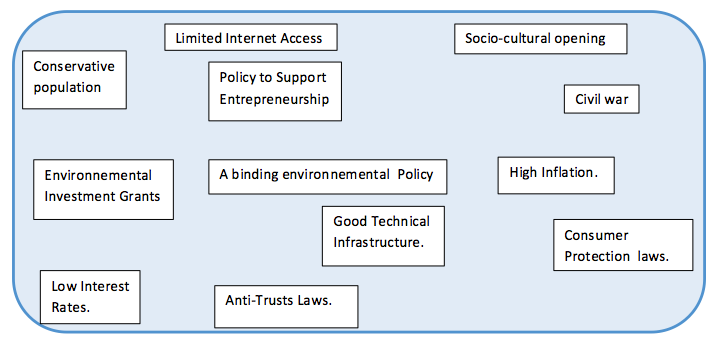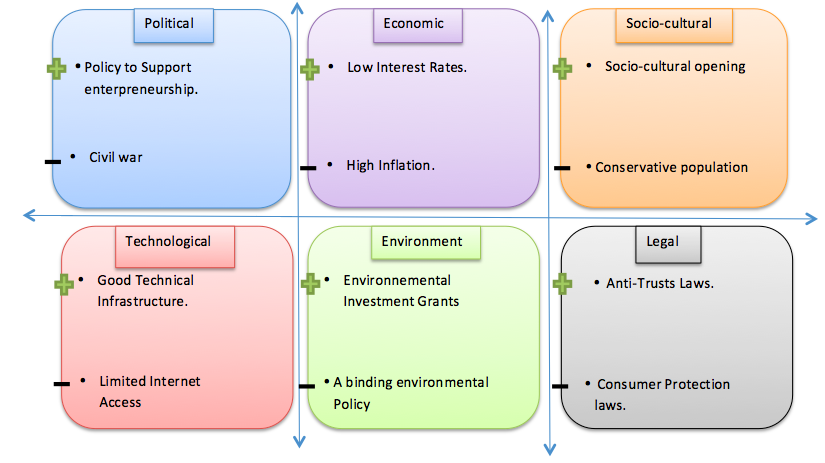PESTLE Analysis
From Learning and training wiki
|
The PESTLE analysis is a tool that helps a new or established company understand its environment in order to anticipate challenges and opportunities it will have to face. Accordingly, it will be able to make informed decisions and establish strategies to ensure risks reduction and optimize chances of success. It is a more comprehensive version of SWOT analysis as it tackles every aspect of an existing market.
Political Economical Socio-Cultural Technological Legislative Environmental[1]
PESTLE Analysis is important for three reasons: 1. By using PESTLE efficiently, the company ensures that its actions are in tune with the trends. This way, it will have a much better chance of succeeding. 2. A good use of PESTLE analysis will avoid the company lethal mistakes. 3. PESTLE is particularly useful when the company decides to enter into a new market sector or in a new country. Indeed the PESTLE analysis can free the company from prejudices and can allow it to adapt quickly to a new environment.
How to use PESTLE: [2] The most efficient way to use PESTLE is divided into three steps [3]:
2. Once the brainstorm session is carried out, identify issues that correspond to the 6 PESTLE factors previously discussed. See below:
3. This is the most important step of the PESTLE analysis, as it isn't merely a description of the identified factors, but rather a construction of their meaning in accordance with an entrepreneurship project. Therefore, we strongly suggest adopting a critical approach and not underestimate this phase.
By now, thanks to the table above you may see a bigger picture and ask yourself the tough questions. You should know where to look and what to focus your research on. The objective is to formulate hypotheses and elaborate future scenarios in terms of risks and opportunities. By the end of this step, you shall be able to establish a conclusion and a strategic plan for the company.
The advantages of using the PESTLE tool are:
• The tool helps understand the business environment better. • The tool encourages the development of strategic thinking. • The tool helps reduce the effect of future business threats. • The tool enables projects to spot new opportunities and exploit them effectively.
The disadvantages of using the PESTLE tool are:
• The tool needs to be updated regularly to be effective. • The tool is most effective when users come from different perspectives and departments. • The tool requires users to have access to data sources which could be time consuming and expensive. • Much of the data used by the tool is on an assumption basis. • The business environment is changing drastically. Thus, it is becoming increasingly difficult for projects to anticipate developments.[4] See also: SWOT Analysis |
|
1. Political: analyses the extent to which the government leverages the economy through tax policies, fiscal policies, trade tariffs and so on having thus an impact on the company’s business. 2. Economic: analyses the overall performance of the economy, which determines the way that companies will prise their products and services. The economic factors are: inflation rate, interest rate, foreign exchange rate, economic growth patterns, foreign direct investment, etc. 3. Social: analyses social factors like culture, population analytics, demographics and so on, which can determine the buying trends of the companies’ products. 4. Technological: considers the existent technological innovation and its impact on the market. 5. Legal: examines the legal aspect of a market from two different perspective: one related to the laws within the business environment of a specific country and the other related to the policies of the companies. According to these two perspectives and their matching degree, companies choose certain strategies over others. 6. Environment: refers to environmental factors, namely: geographical location, climate and weather. The main businesses exposed to these factors are agri-businesses, farming, etc.[5][6] |
| Link | Content |
|---|---|
| What is a PESTLE Analysis and how to use it? | This brief article explains what a PESTLE Analysis is and applies it to one concrete example. |
| PESTLE & SWOT analyses | This article compares both types of analyses, and explains its strengths and weaknesses. |
| Marketing Theories: PESTLE Analysis | This entry goes more in detail as to what the PESTLE factors are. |
| Reason to Use SWOT & PESTLE Analysis | Here is why you must use either of these analyses to improve your marketing and outcomes! |
| PESTLE Analysis Tool | Here is a very useful PESTLE template to be able to conduct the analysis yourself! |
References
- ↑ Analyse PESTLE for Monitoring your Business or Organization http://pestleanalysis.com/analyse-pestel/
- ↑ Understanding PEST Analysis with Definitions and Examples http://pestleanalysis.com/pest-analysis/
- ↑ PEST Analysis http://www.mindtools.com/pages/article/newTMC_09.htm
- ↑ Components of a PESTLE Analysis http://www.brighthubpm.com/project-planning/51754-components-of-a-pestle-analysis/
- ↑ PESTLE Analysis http://en.wikipedia.org/wiki/PEST_analysis
- ↑ PEST Analysis Healthcare UK http://www.myquestions.co.uk/archives/pauls-pestle-analysis-uk-healthcare-march-2012/

